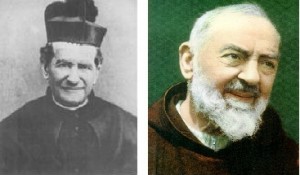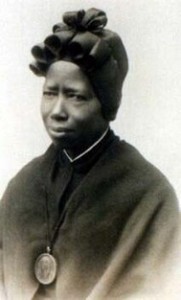When you think about it, our human condition is pretty fragile. We are often troubled by vacant, empty minds and, at times, we do not know quite what to say, what to think, or what to do, in a variety of differing circumstances. We are surrounded by a world which is described in the first letter of St. John as being “….. under the power of the evil one”, (1 John, 19), and so it is not surprising that, sometimes, we are simply not able to think, speak or act, in an appropriate way; it is at times like this that we can easily be swayed to speak and act inappropriately; often, it is then that we act contrary to God’s Love and his Law.
Saints live in this very same world; not from nature, but by an act of will, they choose to be different, by the grace of God, and in their response to that grace. A friend of mine was telling me of the joy, he and his wife experienced, looking at the lives of two saints, on film, that one can view in roughly 10 minute episodes, on the Internet’s ‘Utube’.
 |
SS. John Bosco and Padre Pio
The two are St. John Bosco and Padre Pio, and recently, I have had the chance to watch the whole of the long film on John Bosco (the founder of the Salesians), also the first two episodes on the life of Padre Pio. Both were remarkable men, and even as young boys, both were clearly marked as ‘different’; already, both felt some special relationship with God. (Anyone who wishes, should they desire, can mirror my actions and open up ‘Utube’ on the Web, and find these films in the ‘video section’. They are very professionally produced).
As a young boy, Francesco Forgione of Pietralcina (the future Padre Pio) according to the biography in Wikipedia, is portrayed as having a close relationship with Jesus, Mary and Joseph. The article states:
“It is claimed by his mother that Francesco was able to see and speak with Jesus, the Virgin Mary and his guardian angel, and that as a child, he assumed that all people could do so. As a youth Pio claimed to have experienced heavenly visions and ecstasies.”
In the film, he is shown, one day, minding the sheep in the fields, when a Cappuchin Friar, Brother Casimiro, ‘stumbles’ across him and they become friends. The conversation turns to Jesus, Mary and Joseph, and, in a charming scene, the little boy asks Casimiro if he had talked with these members of the Holy Family? “No, I don’t have that direct privilege” he replied. “Oh, I talk to them a lot, and I’ll ask them to make themselves known to you”, replies Francesco. Later, it becomes apparent that it was the example of Brother Casimiro that inspires the young boy to become a Cappuchin himself.
In his Encyclical Letter ‘Spe Salvi’ (Hope of the Saved, referring to Rom. 8:24) Pope Benedict asks the important question: “What sort of hope could ever justify the statement that, on the basis of that hope, and the implication that, because it exists, we are redeemed?”
 |
St. Josephine Bakhita
He explains what this hope could be, using other texts from Scripture, together with good and easy to follow, simple arguments, but the best explanation, for me, is given by a short outline of the life of an African saint – recently canonised by Pope John Paul II – Josephine Bakhita, (1849-1947), who was a young Sudanese girl, enslaved, incredibly badly treated, flogged unmercifully and sold on five different occasions. Most people would have ‘given up on life’ with that kind of record, but not Josephine; through God’s providence, she was brought to Italy, where eventually, she became a Christian and later entered the Order of the Canossian Sisters. Recognised as having lived a long and holy life, she was canonised on 1st October 2000.
I suspect that everyone can be lifted out of their misery, if they follow the call of God in their hearts, but, for this to happen, there needs to be a loving culture – I think of it as a ‘support mechanism’ – if one is to overcome the terrible distortions that abusive evil can practise on the mind and heart of a person. Both John Bosco, and Padre Pio, had very difficult early lives, in that they were bullied and suffered severe poverty; they did, however, have the advantages of knowing the one true God, and of living in families, where God’s presence was recognised, lived out and shared. Even people, in our time, who have lost all sense of purpose and joy in life, can be lifted into a new existence of love, peace, joy and of ‘giving’ in order to ‘find’ the true meaning of their lives.
We, in the Priory at Leyland, have the continuing privilege of accompanying Father Ambrose, on his last journey. He is also a living witness to that hope which is an assurance of redemption. In his company, we are surrounded by – conscious of – true witness to the presence of God. Despite being, more or less in bed and immobile, all day – despite the long hours of waiting, hours of exhausted sleep, there are punctuating moments of ‘palpable’, conscious awareness, in which great encouragement, unbreakable hope and trust in God, and love for those who have come to see him, manifest Fr. Ambrose’s response to his condition, that of suffering from an aggressive form of leukaemia. No! I am not attempting to ‘canonise’ Fr. Ambrose, but I am witnessing to the great things God has worked through him; there are innumerable cards and letters of appreciation from people all over Britain – from different denominations – that refer to the effect he has had on their lives. It would have been a gift – to any parish – to have had a successor of the Apostles among its people; but this, has been our situation, for the past seven years, in Leyland. Father Ambrose’s personal dedication, to God alone, is a great witness.
The saints, by their example, show us a different way to live. It is well worthwhile learning from them!
(In sending out this blog by e-mail, ‘Word Press’ distorts the original formatting of the document. Readers are, therefore, advised to visit the website www.stmarysblog.co.uk should they wish to read it in its intended format).
